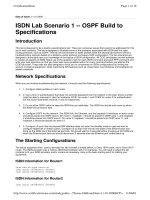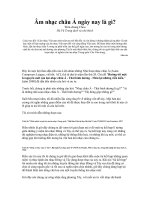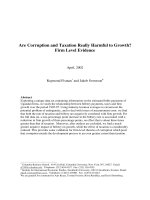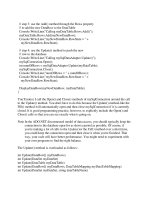Tài liệu OCCUPATIONAL CANCER/ZERO CANCER: A union guide to prevention docx
Bạn đang xem bản rút gọn của tài liệu. Xem và tải ngay bản đầy đủ của tài liệu tại đây (1.91 MB, 16 trang )
OCCUPATIONAL CANCER/ZERO CANCER
A union guide to prevention
Occupational cancer/
Zero cancer
Work started it…
Unions will stop it
© 2007, International
Metalworkers’ Federation
International Metalworkers’
Federation (IMF)
54-bis, route des Acacias
Case Postale 1516
CH-1227 Geneva, Switzerland
www.imfmetal.org
Text by Rory O’Neill
Design by Mary Schrider
Printed by Tabergs Tryckeri AB
www.tabergmediagroup.com
Available in English, French,
Spanish and Russian.
Produced with the support of:
ITUC, BWI, EI, ICEM, IFJ, ITF,
ITGLWF, IUF, PSI, UNI
DEAD SERIOUS
Occupational cancer, the workplace’s deadly secret. 4/5
CANCER EXPOSURE
At least 1 in 5 face a risk just by doing their job. 6/7
A JOB TO DIE FOR?
New and old workplaces put workers at risk. 8/9
WORKPLACE DETECTIVE
How you can identify the workplace killers. 10/11
UNION ACTION
Working together to produce a healthy workplace. 12/13
GLOBAL PRIORITY
Everything you need to know. 14/15
You don’t hear much about occupational cancer. You hear about cancer the
tragedy for the individual, cancer the challenge for the medical profession,
cancer the result of smoking and bad diet. But at least one in every 10
cancers – and probably many more – is the result of preventable, predictable
workplace exposures. Asbestos is the biggest industrial killer of all time, and
kills thousands from cancer every single week, at least one death every five
minutes. But it is not banned worldwide.
Dozens of other substances known to cause cancer are used, quite
literally, in industrial quantities in our workplaces, frequently with few controls.
They are not yesterday’s problem. At work, we face a barrage of rapidly
evolving substances, work methods, processes and environments with little
thought given to the health consequences that will face society – workers,
families, entire communities – a working generation down the road. Because
today’s exposures cause cancers at least two decades later, it is a problem
that doesn’t cause alarm bells for corporate executives who are answerable to
shareholders from annual general meeting to annual general meeting. Instead,
the causes are covered-up, the bodies are buried and the killing continues.
But not any more. Unions are challenging workplace cancer risks. Asbestos
bans are spreading, despite a cash-rich rearguard public relations offensive by
the asbestos industry. Unions have won recognition of causes of occupational
cancer, restrictions on their use and compensation for their victims. Prevention,
though, is the only cure. That’s why, through advice, training and union action
at workplace, national and international levels, this campaign intends to ensure
workplace ill-health is not the forgotten item on the cost-benefit ledger. Work
should provide a living, not a cause of death.
Catching
cancers
CAMPAIGN
3
A global union campaign
4 Occupational Cancer/Zero Cancer
Learning lessons
Asbestos is the world’s biggest ever industrial
killer. Studies suggest asbestos disease could eventually account
for 10 million deaths worldwide. At least 100,000 die each year – one
person every five minutes. Despite its deadly history, there is no
worldwide ban and there is even evidence asbestos production could
be increasing. While many richer nations will no longer tolerate its
use and have introduced stringent laws controlling the asbestos
that remains in workplaces, the same cannot be said for developing
nations. And it is these nations that are being targeted by the global
asbestos industry lobby.
Asbestos cancer rates are still climbing in many industrialised
nations. Unless we learn the lessons of these deaths, we’ll see a
new generation killed by new epidemics – same tragedy, different
location. There are signs we can stop history repeating itself.
After a high profile union campaign, international organisations
including the International Labour Organisation (ILO) and the
World Health Organisation (WHO) are now backing the union call
for a worldwide ban.
It took decades of campaigning to get this far with asbestos.
But we are still introducing new substances and new technologies
– for example, nanotechnology – to workplaces without the
necessary investigations and precautions. We are already seeing
raised cancer rates in some computer factories, a supposed
“clean industry” which is just one working generation old.
www.imfmetal.org/asbestos
How much is caused by work?
“Studies worldwide suggest
the occupational contribution
to the cancer total is between
8 and 16 per cent.”
Burying the evidence, Hazards Magazine,
Number 92, 2005. www.hazards.org/cancer
Dead
Occupational Cancer/Zero Cancer
5
Organisational names for folio?
Serious
NUMBERS
Occupational cancer is the forgotten epidemic. However, the International
Labour Office (ILO) says it is far and away the most common work-related
cause of death, leaving accidents and other occupational diseases well behind.
It estimates occupational cancers make up almost one-third of all work-related
deaths. Why occupational cancer is considered yesterday’s problem or no
problem at all is down to one clear factor. The industries creating the risks
have gone out of their way to ensure they are allowed to make, market and
profit from the substances responsible. And admitting the problem could mean
possible liability in the courts.
Cancer is a very modern killer. For example, lung cancers were virtually
unknown a century ago. Since then almost 100,000 synthetic chemicals
have been introduced to our workplaces, with many more people exposed to
many more substances. The most commonly cited figure for the workplace
contribution to the total cancer toll is 4 per cent of all cancers. But this figure
is derived from a study over quarter of a century ago. The lead author was
receiving substantial undeclared income from industry. And the findings just
didn’t add up. Large swathes of the at-risk workforce were excluded from the
analysis. Retired workers were excluded too – despite being the workers most
likely to develop work-related cancers. Far more people are exposed to far more
substances than they were willing to admit.
Studies of actual work-related cancer levels have concluded the true
contribution of work to cancer deaths at up to five times this level. Recent
reviews suggest a workplace contribution of between 8 and 16 per cent to all
cancers. ILO’s cautious estimate puts the human toll at over 600,000 deaths
a year – one death every 52 seconds. But this isn’t the whole story. Not
everyone is at risk. The great majority of occupational cancers are concentrated
in blue collar jobs, meaning those workers face a massively increased risk, while
others face virtually none. For some workers in some jobs – certain asbestos
and rubber industry workers, for example – work was in effect a death sentence.
WHAT’S KILLING
YOU AT WORK?
Causes of work-related
deaths worldwide.
Cancers: 32%
Circulatory disease: 26%
Work accidents: 17%
5
A global union campaign
Cancer
More people today face a workplace cancer
risk than at any other time in history.
It’s just that most of them don’t know it.
A World Health Organisation (WHO)
study concluded 20-30 per cent of males and
5-20 per cent of females in the working-age
population could have been exposed to an
occupational lung cancer risk during their
working lives.
Figures from the French national statistic
office DARES published in 2005 revealed
more than 1 in 8 workers was exposed to
workplace substances that can cause cancer.
It concluded 13.5 per cent of the total French
workforce was exposed to one or more
workplace carcinogen. The figure was higher
What causes cancer?
Commonly encountered workplace
exposures to chemical, physical and
biological agents can place workers
at risk.
Metals such as arsenic, chromium and nickel linked
to cancers of the bladder, lung, and skin.
Chlorination byproducts such as trihalomethanes
linked to bladder cancer.
Natural substances such as asbestos linked to
cancers of the larynx, lung, mesothelioma, and
stomach; silica linked to lung cancer; aflatoxin
contamination on nuts linked to liver cancer.
Petrochemicals and combustion products, including
motor vehicle exhaust and polycyclic aromatic
hydrocarbons (PAHs), linked to cancers of the bladder,
lung, and skin.
Pesticide exposures linked to brain cancer, Wilms’
tumour, leukaemia, and non-Hodgkin’s lymphoma.
Reactive chemicals such as vinyl chloride linked to
liver cancer and soft tissue sarcoma.
Metalworking fluids and mineral oils linked to cancers
of the bladder, larynx, nasal passages, rectum, skin,
and stomach.
Ionising radiation linked to cancers of the bladder, bone,
brain, breast, liver, lung, ovary, skin, and thyroid, as well
as leukaemia, multiple myeloma, and sarcomas.
Solvents such as benzene linked to leukaemia and
non-Hodgkin’s lymphoma; tetrachloroethylene linked to
bladder cancer; and trichloroethylene linked to Hodgkin’s
disease, leukaemia, and kidney and liver cancers.
Environmental tobacco smoke linked to cancers of the
breast and lung.
What are they
talking about?
Studies on cancer use their own jargon.
Carcinogen: Something that can cause cancer.
Mortality: When it kills you.
Morbidity: When it makes you sick.
Epidemiology: Counting the bodies to see
if there is a risk of disease.
Occupational Cancer/Zero Cancer
HAZARDS
How does it happen?
There are three main ways workers are exposed to
a workplace cancer risk – they can touch it, breathe
it or swallow it.
Skin exposure – either by touching the substance
or being exposed by other means, for example skin
exposure to sunlight or radiation.
Ingestion – swallowing hazardous substances,
perhaps contaminating food, drink or skin.
Inhalation – breathing in gases, fumes or vapours.
Exposure
than estimates a decade earlier. Blue collar workers were eight times more
likely than managers to be at risk, with 25 per cent exposed. Eight products
contributed more than two-thirds of all exposures – mineral oils, three organic
solvents, asbestos, wood dust, diesel exhaust fumes and crystalline silica.
The European Union’s CAREX database of occupational exposures to
carcinogens estimated that in the early 1990s 22-24 million workers in the
then 15 EU member states were exposed to carcinogens classified as group 1
by the International Agency for Research on Cancer – those known to cause
cancer in humans.
Overall, 32 million workers, 23 per cent of the working population,
had workplace exposures associated by the CAREX database with an
occupational cancer risk. The most common exposures were solar radiation,
environmental tobacco smoke, crystalline silica, radon and wood dust.
That over 1 in 5 workers face a workplace cancer risk shouldn’t be a surprise.
About 95 per cent of causes of lung cancer, for example, were identified in
workplace studies.
What’s the risk?
More than 1 in 5 workers could be exposed to a workplace
cancer risk.
Occupational cancer is not a disease that concerns the
boardroom. The risk is far higher in blue collar jobs.
Most causes of cancer were identified in studies of
workers.
The International Agency for Research on Cancer (IARC)
lists over 50 substances which are known or probable
causes of workplace cancer, and over 100 other possibles.
7
A global union campaign
DOES YOUR JOB
PUT YOU AT RISK?
Cancers associated with workplace substances:
Bladder cancer Arsenic; solvents; aromatic
amines; petrochemicals and combustion
products; metalworking fluids and mineral oils;
ionising radiation.
Bone cancer Ionising radiation.
Brain and other central nervous system cancers
Lead; arsenic; mercury; solvents, including
benzene, toluene, xylene and methylene
chloride; pesticides; n-nitroso compounds.
Breast cancer Ionising radiation; endocrine
disrupters; solvents; passive smoking; PCBs;
pesticides; combustion by-products; reactive
chemicals including ethylene oxide; possible
links to non-ionising radiation, phthalates.
Colon cancer Limited evidence for solvents
xylene and toluene and ionising radiation.
Hodgkin’s disease Solvents; pesticides;
woodworking.
Kidney cancer Evidence sketchy because of
high survival rates, but some links to arsenic,
cadmium and lead; solvent exposure; petroleum
products; pesticides linked to Wilms’ tumour in
children, and to the children of fathers employed
as mechanics or welders.
Laryngeal cancer Metalworking fluids and
mineral oils; natural fibres including asbestos;
some evidence for wood dust; exposure to
reactive chemicals including sulphuric acids.
Excesses in rubber workers, nickel refining, and
mustard gas and chemical production.
Leukaemia Organic solvents and chlorinated
solvents, paints and pigments; reactive
chemicals; ionising radiation; conflicting
evidence on non-ionising radiation; pesticides.
Liver and biliary cancer Ionising radiation; vinyl
chloride and angiosarcoma of the liver; PCBs.
Some evidence for arsenic, chlorinated solvents
and reactive chemicals.
Lung cancer Arsenic; beryllium; cadmium;
chromium; nickel; solvents, particularly aromatics
(benzene and toluene); ionising radiation,
including radon-exposed uranium, haematite and
other ore miners; reactive chemicals including
BCME, CCME, mustard gas, plus suggestive
evidence for sulphuric acids; passive smoking;
petrochemicals and combustion byproducts;
asbestos; silica; wood dust; some man-made
fibres, including ceramic fibres.
Mesothelioma Asbestos; erionite.
A JOB TO
DIE FOR?
Certain jobs have a notorious reputation for causing cancer.
Asbestos and lung cancer and mesothelioma, a cruel and
invariably fatal cancer. Vinyl chloride exposure and liver
cancer. Work in the rubber industry and bladder cancer. And
nasal cancer and work with wood or leather dust.
But many other jobs have a risk which is just as real,
but which is less commonly known. The man who delivered
the milk to an asbestos factory in Canada got cancer as a
result. Nurses handling cancer drugs can be at risk. And
workers in newer industries, like microelectronics, may have
to wait until evidence – a sufficiently high pile of bodies
– emerges confirming they were at risk.
Even with “clean” technology and improved, modern,
workplace safety practices, the risks can be real.
A 2006 US study using the firm’s own ‘Corporate
Mortality File’, found staff employed at IBM computer
factories had high rates of a range of cancers linked to
exposures to chemicals and electromagnetic fields.
Studies have found similar problems in computer
factories in other countries.
Office jobs too can have their risks. After Australian
media union MEAA raised concerns about apparently
high breast cancer risks in the broadcaster’s Brisbane
studios, the findings were confirmed in a management-
commissioned study. The studio was shut down.
Other factors, like shiftwork and passive smoking,
have also been linked to occupational cancers.
8
Occupational Cancer/Zero Cancer
A global union campaign
Why work cancers get missed
Common cancers Dusty jobs in general have a
higher lung cancer rate, but because lung cancer
is common and is often caused by smoking, the
link to work is usually missed.
Inadequate studies Most of what we know about
occupational cancer is based on big studies
in industrial workplaces. These miss many jobs
dominated by women, for example, or workers
in small firms.
New factors New substances or processes can
present new risks. By the time cancers emerge,
the substance, process and even the workplace
may be long gone.
Unexpected exposures Hairdressers have de-
veloped asbestos cancers, caused by asbestos
used in hairdryers. Teachers, nurses and doctors
have developed the same cancers caused by
asbestos used in their workplaces.
Paying the price Industry financed studies and
lobbying ensure evidence of risks posed by
some jobs is suppressed or played down.
Multiple myeloma Some
evidence for a link to
solvents, ionising radiation,
pesticides and dye products.
Nasal and nasopharynx
cancer Chromium; nickel;
some evidence for benzene,
reactive chemicals and
formaldehyde; metalworking
fluids; natural fibres including
wood dust; ionising radiation.
Associated with work in
footwear manufacture.
Non-Hodgkin’s lymphoma
Organic solvents; pesticides.
Some evidence for PCBs and
dioxin and possibly dye products.
Oesophageal cancer Suggestive evidence
for solvent exposure, particularly
tetrachloroethylene; metalworking fluids.
Ovarian cancer Limited evidence for pesticides
and ionising radiation. Limited evidence for an
excess in hairdressers and beauticians.
Pancreatic cancer Acrylamide; metalworking
fluids and mineral oils. Some evidence for
cadmium, nickel, solvent exposure, reactive
chemicals, possibly formaldehyde. Limited
evidence for pesticides.
Prostate cancer Links to cadmium, arsenic and
some pesticides. Excess risks have been found
for exposure to metallic dusts and metalworking
fluids, PAHs and liquid fuel combustion
products, and farmers and pesticide applicators.
Rectal cancer Metalworking fluids and mineral
oils. Some evidence for solvents, including
toluene and xylene.
Skin cancer UV and sun exposure; metalworking
fluids and mineral oils; Non-melanoma skin
cancers from arsenic, creosote, PAHs, coal tars
and ionising radiation.
Soft tissue sarcomas Vinyl chloride monomer
(angiosarcoma of the liver); pesticides. Ewing’s
sarcoma in pesticide exposed workers.
Stomach cancer Ionising radiation;
metalworking fluids and mineral oils; asbestos.
Some evidence for solvents and pesticides.
Excess risks found in workers in the rubber, coal,
iron, lead, zinc and gold mining industries.
Testicular cancer Evidence for endocrine
disrupting chemicals (eg. phthalates, PCBs and
polyhalogenated hydrocarbons). A literature review
found significantly elevated risks in men working
in industries including agriculture, tanning and
mechanical industries, and consistent associations
with painting, mining, plastics, metalworking and
occupational use of hand-held radar.
Thyroid cancer Ionising radiation.
RISKS
9
Occupational Cancer/Zero Cancer
A global union campaign
Workplace
Detective
If you think sticking your head in the text books will give you all the
answers about workplace cancer risks, you’d be wrong. Barely one in
every 100 chemicals used at work has been systematically tested.
Finding out if there is a workplace risk requires union vigilance. That
means doing your own detective work. Unions have been instrumental
in first identifying a number of workplace cancers, from bladder cancer
in dye workers to liver cancer in vinyl chloride workers.
Remember, keep it as simple as possible. A quick discussion at a
union meeting might provide all the information you need. Just make
sure you involve the workforce – they know their jobs, their workmates
and the real hazards of the job.
WHAT’S THE PROBLEM?
Ask around: Has one part of the workplace got high
levels of sickness absence? Are you aware of cases of
cancer in workers or ex-workers? Are affected workers
all doing similar jobs or using the same substances,
for example working in the foundry, cutting stone or
handling toxic chemicals? Check with other union
reps and colleagues, particularly those who have been
at the firm or working in the industry for a long time.
10 Occupational Cancer/Zero Cancer
Risk mapping Draw a basic map of the workplace, marking on it the
machines, workstations and the substances or processes used. Record on
the risk map any health problems reported by workers doing particular jobs.
Repeat the exercise periodically and see if any problems become apparent.
If cancer causing substances or processes are being used, investigate
alternatives and, if this is not possible, safer work methods.
Body mapping Draw two body outlines on a large piece of paper, one
representing the front of a person, one the back. Get workers to write on
where they feel pain or have had health problems or symptoms. If workers
doing similar jobs identify similar problems, then you can start linking
workplace factors to their health concerns.
Investigate Review existing sources, like workplace sick leave, accident,
compensation and pension records. Don’t forget retired members – many
cancers take decades to emerge, so may only occur after a worker has finished
working. Newspaper reports may highlight local deaths linked to occupational
disease. Where there is a suspicion of a problem, dig deeper.
Surveys Do-it-yourself research can quickly identify problems. This need not
be a highly scientific and time-consuming business. A union rep could ask
workers on their lunch break if they have concerns about a particular job or
substance, or if they had noticed any worrying sick leave trends or causes of
ill-health in their workmates.
Get your priorities right If you find out a cancer-causing substance or process
is in use, negotiate safer substances, processes or work methods immediately.
The best way to ensure you don’t find any cancers in your workplace is to
ensure there are no jobs where workers are at risk.
WHAT’S THE PROBLEM?
PREVENTION
11Occupational Cancer/Zero Cancer
A global union campaign
UNION
ACTION
Union campaigns have been critical in identifying and
addressing occupational cancer risks. But fighting each
problem case-by-case is no substitute for a properly
designed, strategic cancer prevention strategy.
A successful union ‘prevent cancer campaign’ relies
on both national union commitment and resources and
participation by active and informed local union reps and
members. And it requires vigilance, to ensure promised
improvements are effectively implemented.
Local union action
List substances and processes that are known or suspected hazards. Locations where
cancer agents may be found should be noted and exposed workers should be informed.
Make sure the company has informed workers who are exposed to potential cancer risks
and other hazards.
Seek medical screening programmes for workers who have had exposure to workplace
hazards, including possible cancer risks. This should include retired members, who are
most likely to develop work-related cancers.
Negotiate strict controls, even where minimum government standards are being met.
Remember, there is no safe exposure to a cancer agent.
Remember the basic control techniques: substitution; process changes; enclosure;
local exhaust ventilation; strict housekeeping; and protective equipment.
Make sure real improvements are being implemented – making the workplace safer
and providing necessary support and information for workers who have been put at risk.
National union action
Consider which workplace and industries
pose a possible cancer risk. Remember,
the existing workforce may be healthy
– the cancers may only appear after they
have retired.
Review studies or reports to identify existing
evidence of possible problem workplace
and industries.
Where problem workplaces are identified,
press the company to report on possible
risks and the controls in place, and where
necessary to fund and cooperate with
research.
Organise an awareness campaign,
highlighting risks and prevention strategies,
and urging workers with possibly work-
related cancers to contact the union.
12 Occupational Cancer/Zero Cancer
First steps for union reps
1
Identify possible cancer risks in the
workplace. This is a job for the union
health and safety representatives, the safety
committee or a union-organised “cancer
prevention” committee.
2
Insist substances or processes presenting
a cancer risk are where possible removed
and substituted with less hazardous
substances or safer work methods. Set
priorities for action. Union priorities for
dealing with risks are in order: elimination;
substitution; control; and if nothing else is
possible, personal protective equipment such
as masks or protective clothing.
3
Ensure workers with work-related cancers
are given the support they need and receive
any sickness or compensation payments to
which they are entitled.
4
Ensure community support by making
sure the public knows about air emissions
and hazardous waste from the workplace
that may be a cancer concern.
5
Don’t act alone – make
sure the prevent
cancer campaign
has the support
of the workforce
and of the union
in the workplace
and at local and
national levels.
Short-term response
When a work-related cancer risk is suspected
in a particular workplace, a short-term
investigation by union reps could include:
1
Gathering available evidence, for example
death certificates or pension or sickness
records, or industrial hygiene, health or media
reports. List possible cancer risks in the
workplace.
2
Analysis of the information by the local
union – is there a suspicion that a
workplace or a part of the workplace has more
than expected numbers of cancers? Are there
exposures in the workplace that could place
workers at risk?
3
Where workers have been exposed to a
possible cancer risk, it is important they
receive regular medical check-ups that could
detect cancer in its early stages.
4
Call on the government, safety authorities,
the company, universities or supportive
workers’ health groups to undertake more
comprehensive studies when needed.
5
Ensure possible cancer risks are properly
assessed – don’t accept assurances that
exposures are at a “safe” level. And remember
official exposure limits are not the same thing
as a safe level.
6
Make sure the workplace is made safer
– make recommendations for substitution,
using less hazardous substances or processes,
and for engineering controls.
GETTING STARTED
13
A global union campaign
Global
The International Labour Organisation (ILO) convention on occupational
cancer makes clear, commonsense recommendations which could and
should be followed everywhere. There’s good reason for occupational
cancer to be an ILO priority – it says it is the top cause of work-related
deaths worldwide, killing one person every 52 seconds.
The convention, C139, requires ratifying countries to:
Periodically determine the carcinogenic substances and
agents to which occupational exposure shall be prohibited
or made subject of authorisation and control.
Make every effort to replace carcinogenic substances and
agents with non-carcinogenic and less harmful alternatives.
Take measures to reduce to the minimum the number
of workers exposed to carcinogenic substances, and the
duration and degree of exposure and to establish an
appropriate system of records.
Ensure that workers who have been, are, or are likely to
be exposed to carcinogens, are provided with information
on dangers and relevant preventive measures.
Organise medical surveillance of workers at risk,
during and after employment.
By ILO’s estimate, one in every six workplace cancer
deaths is caused by asbestos exposure. The ILO
asbestos convention, C162, calls for action to minimise
risks posed by asbestos.
Key work cancer facts
Occupational cancer is the top
work killer worldwide, ahead
of other work diseases and
accidents.
Over 600,000 workers die of
occupational cancers ever year,
according to ILO – that’s one
death every 52 seconds. The true
toll is certainly much higher.
More than 1 in 5 workers faces a
cancer risk from their work.
Between 8 and 16 per cent of all
cancers are the result of exposures
at work.
Approaching 100,000 chemicals are
used in workplaces worldwide. Barely
1 in a 100 has been thoroughly tested
for health risks.
Over 50 substances are rated by the
United Nations’ International Agency for
Research on Cancer (IARC) as a definite
or probable cancer risk at work. Over
100 more are IARC rated as a possible
cancer risk.
Most causes of cancer were identified in
studies of workers.
It is not just industrial workers that are
at risk. Hairdressers, teachers, nurses,
doctors, farm and office workers and
workers in many other jobs have also died
of occupational cancers.
Tens of thousands of workers generally have
to die before scientific studies identify a
workplace cancer problem. A precautionary
approach is always the safe and healthy option.
Occupational Cancer/Zero Cancer
Priority
A resolution agreed at ILO’s 2006 conference clarified the purpose of the
asbestos convention. It said “the elimination of the future use of asbestos and
the identification and proper management of asbestos currently in place are the
most effective means to protect workers from asbestos exposure and to prevent
future asbestos-related deaths.”
The 2006 resolution added that the convention “should not be used to
provide a justification for, or endorsement of, the continued use of asbestos.”
It instead called for efforts “to promote the elimination of future uses of all
forms of asbestos and asbestos containing materials.”
ILO’s chemicals convention, C170, calls on employers to assess the
exposure of workers to hazardous chemicals; monitor and record the
exposures where necessary; and maintain adequate records and ensure
they “are accessible to the workers and their representatives.”
ILO WEBSITE
ILO conventions: www.ilo.org/ilolex/ • ILO safety: www.ilo.org/safework
ILO workers’ section: www.ilo.org/ratify
GLOBAL
15
A global union campaign
International Metalworkers’
Federation (IMF)
54 bis, route des Acacias
Case Postale 1516
CH-1227 Geneva Switzerland
www.imfmetal.org/cancer
Building and Wood Workers’
International (BWI)
54 route des Acacias CH-1227
Carouge GE Switzerland
www.bwint.org
Education International (EI)
International Trade Union House
5 Boulevard du Roi Albert II
1210 Brussels Belgium
headoffi www.ei-ie.org
International Federation of
Chemical, Energy, Mine and
General Workers’ Unions (ICEM)
Avenue Emile de Béco, 109
B-1050 Brussels Belgium
www.icem.org
International Federation
of Journalists (IFJ)
International Press Centre
Résidence Palace, Block C
155 Rue de la Loi B1040
Brussels Belgium
www.ifj.org
International Textile Garment
and Leather Workers’ Federation
(ITGLWF)
8 rue Joseph Stevens
1000 Brussels Belgium
offi www.itglwf.org
International Transport
Workers’ Federation (ITF)
ITF House, 49-60 Borough Road
London SE1 1DR England
www.itfglobal.org
International Union of Food,
Agricultural, Hotel, Restaurant,
Catering, Tobacco and Allied
Workers’ Associations (IUF)
8 Rampe du Pont Rouge
Petit Lancy, CH-1213
Geneva Switzerland
www.iuf.org
Public Services International (PSI)
45 avenue Voltaire, BP 9
01211 Ferney-Voltaire Cedex France
www.world-psi.org
UNI Global Union
Avenue Reverdil 8-10,
1260 Nyon Switzerland
www.union-network.org
International Trade Union
Confederation (ITUC)
5 Boulevard du Roi Albert II
Bte 1 1210 Brussels Belgium
www.ituc-csi.org









